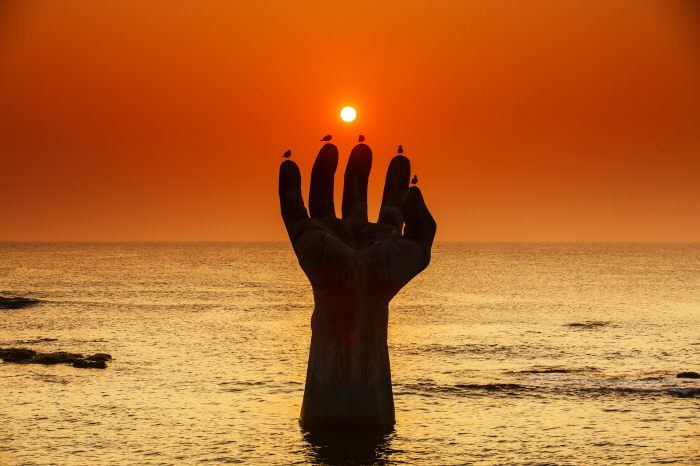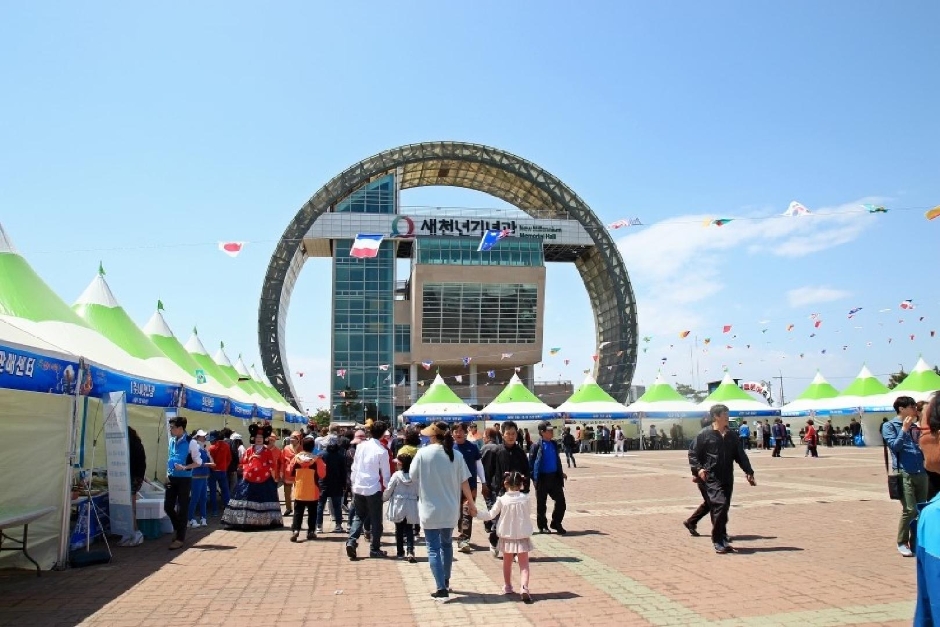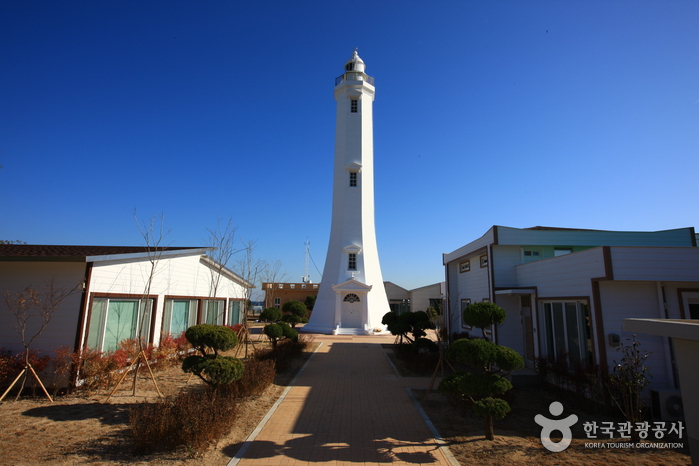Igari Anchor Observatory (이가리 닻 전망대)
12.8 Km 0 2023-01-02
Iga-ri, Buk-gu, Pohang-si, Gyeongsangbuk-do
+82-54-270-3204
Igari Anchor Observatory, located in Iga-ri, Cheongha-myeon, Buk-gu, Pohang-si, is an observatory in the shape of an anchor that anchors ships near the beautiful beach and blue sea pines. With a x_height of 10 meters and a length of 102 meters, visitors can see the open sea of Pohang at a glance. It is also a popular attraction visited by many tourists as the main filming location for the popular drama "Run On (2020)."
Yeongil Bay Hot Springs (영일만온천)
13.0 Km 22503 2020-03-18
21, Unje-ro 386beon-gil, Nam-gu, Pohang-si, Gyeongsangbuk-do
+82-54-285-0101
The construction of this huge hot spring complex started in Yeongil Bay in 1988 after it was found that Yeongil Bay has the highest geothermal heat in Korea while drilling for oil in 1974.
The water’s main ingredients contain healthy minerals such as calcium, natrium, fluorine, magnesium, chlorine, sulfuric acid, fluorine, zinc, germanium and radium. Yeongil Bay Hot Springs maintains its water with alkali bicarbonate at a pH of 9.43. The temperature of the water is somewhat low though at 35℃.
The hot springs help to recover from fatigue, to help beauty care, anti-aging, neuralgia, heart disease, and liver functions. The water here also has a very unique texture.
Hyangdan [Korea Quality] / 향단 [한국관광 품질인증]
14.5 Km 42643 2023-09-05
121-83 , Yangdongmaeul-gil, Gyeongju-si, Gyeongsangbuk-do
+82-10-6689-3575
Hyangdan in Yangdong Village, Gyeongju, Gyeongsangbuk-do, is a grand old house designated as a national treasure, having been built by King Jungjong for the elderly mother of his courtier Yi Eonjeok. Much of the original 99-kan house was destroyed during the Korean War and the rest converted to a guesthouse. Visitors can stay in the anchae, haengnangchae and an annexe - which all appear to be different x_heights because of the upward slope of the site. Various experience programs are offered: woodblock printing, a tea ceremony, natural dyeing, and traditional etiquette.
Gyeongju Yangdong Village [UNESCO World Heritage] (경주 양동마을 [유네스코 세계문화유산])
14.7 Km 87901 2022-11-08
134 , Yangdongmaeul-gil, Gyeongju-si, Gyeongsangbuk-do
+82-54-762-2630
Gyeongju Yangdong Village is Korea’s largest traditional village, showcasing the traditional culture of the Joseon dynasty and the beautiful natural surroundings. Thanks to its many cultural heritages, including treasures, national treasures, and folklore materials, the entire village has been designated as a cultural heritage site. Many people have visited this village to see its wealth of cultural heritages and scenic surroundings, including King Charles III, who visited this village in 1993.
Seolchangsan Mountain and its four spines of mountains can be seen beyond the village. Approximately 160 old houses and 500-year-old thatched-roof cottages are nestled within the valley. Fifty-four of these homes are over 200 years old and have been excellently preserved in their original state, offering the opportunity to view a variety of unique traditional Korean houses in person.
Homigot Sunrise Festival (호미곶 한민족 해맞이축전)
15.5 Km 20816 2022-12-14
136, Haemaji-ro, Nam-gu, Pohang-si, Gyeongsangbuk-do
• 1330 Travel Hotline: +82-2-1330 (Korean, English, Japanese, Chinese) • For more info: +82-54-289-7852~8
Homigot Village, the main venue of the Homigot Sunrise Festival, is located on the easternmost point of the Korean Peninsula. Homigot Village means "a village on a tiger’s tail," in reference to the Korean peninsula looking like a tiger.
The festival includes local cultural performances, a New Year celebratory event, fireworks show, sunrise concert and other diverse performances. Visitors may sample free tteokguk, a traditional New Year’s Day dish. Other events such as kite-flying and launching hope balloons with wishes attached will provide enjoyable moments to reflect on the previous year and create new year resolutions.
Homigot Octopus Festival (호미곶 돌문어 수산물 축제)
15.5 Km 4556 2024-04-17
136 Haemaji-ro, Homigot-myeon, Nam-gu, Pohang-si, Gyeongsangbuk-do
+82-54-284-0575
The Homigot Octopus Festival is an annual festival held to celebrate the octopus harvested from the rocky coastal area around Homigot Peninsula. The octopus here are known for their chewy texture and high-quality taste. During the festival, visitors can enjoy freshly caught octopus from the East Sea, as well as take pictures in a vast field of canola flowers that bloom near the coast. Additional programs and experiences related to octopus are planned for the enjoyment of all.
Homigot Sunrise Square (호미곶 해맞이광장)
15.6 Km 49400 2023-01-02
20, Haemaji-ro 150beon-gil, Nam-gu, Pohang-si, Gyeongsangbuk-do
+82-54-270-5855
Homigot is located at the easternmost end of the Korean peninsula, in what would be considered to be the tail, if thinking of the Korean peninsula as a tiger. When Kim Jeongho made the Daedongyeojido Map, he visited this place seven times to confirm this area is in fact the easternmost part of Korea. Following the resources of Korea Astronomy and Space Science Institute, the sunrise time of Homigot on January 1 is at 7:32 am, making it the earliest first sunrise of each year in Korea. The plaza was built to commemorate these research findings with the national Sunrise Festival. Nearby attractions include Korea's largest lighthouse, Homigot Lighthouse, established in 1908; Lighthouse Museum; Monument to Commemorate Lee Yuk-sa’s Patriotism; and Daebo Seawater Bath, using pure seawater of the East Sea.
When completed, Homigot Tourism Complex and Homigot Specialized Ocean Leisure Complex will be the largest tourism complex in the eastern coast district. It will include an ocean aquarium, Ocean Ecological Park, Youth Training facilities, beach dome, accommodation facilities, and other various stores as well.
Sangsaeng’s Hand, a two-part bronze sculpture shaped like a pair of hands, was constructed in December 1999. It is a signature symbol of the sunrise festival. The left hand is on the land and the right hand is in the ocean. It was built to give the message that all people are living together by helping one another like Sangsaeng, meaning coexistence in Korean. The base of the platform is an image of the sun and its two round rings refer to harmony. These two hands have memorial sprits of reconciliation and coexistence for celebrating a new millennium.
Homigot Lighthouse (호미곶 등대)
15.6 Km 25235 2021-02-18
20, Haemaji-ro 150beon-gil, Nam-gu, Pohang-si, Gyeongsangbuk-do
+82-54-284-9814
Homigot Lighthouse is located at Homigot Cape, listed as one of the 10 most scenic sites during the Joseon dynasty. It was the tallest lighthouse in Korea at the time of its opening on December 20, 1908. The octagonal, six-story building is 26.4 meters high, with a base circumference of 24 meters. It was built using red bricks and no reinforcing rods, designed in the 18th century renaissance style, with gable decorations over the entrance and windows. The ceiling on each floor is sculpted in the shape of pear blossoms, a symbol of the Joseon royalty, while the number of stairs totals to 108, reflective of Buddhist culture.
Oeosa Temple (오어사(포항))
15.8 Km 38520 2023-01-25
1 , Oeo-ro, Nam-gu, Pohang-si, Gyeongsangbuk-do
+82-54-292-2083
Oeosa Temple in Unjesan Mountain is a place where the deep scent of Buddha can be felt with a lake that looks like a dragon wrapped around it and the strangely-shaped cliffs which harmonizes like an oriental painting. Oeosa Temple is a sacred place where the four great patriarchs of Silla were born. This temple was built during the reign of King Jinpyeong (579-632), the 26th ruler of Silla. It was originally called Hangsasa Temple, but when Great Master Wonhyo and Zen Master Hyegong practiced religious asceticism here, a contest was held to revive the fish in the stream with religious power. However, one of them did not survive, and the other did and swam vigorously.
So each argued that he himself saved the fish, so they called it Oeosa Temple by writing the characters 'O' and 'Eo.' Daeungjeon Hall has a hip-and-gable roof with three bays in the front and two in the side. It was rebuilt in the 17th year of King Yeongjo of the Joseon dynasty (1741). Around the temple, the beautiful natural scenery of Unjesan Mountain and the blue water of Oeoji are spectacular. Jajangam Hermitage can be seen on the rocky cliff, and Wonhyoam Hermitage can be seen to the west of Oeosa Temple. Daeungjeon Hall (Gyeongbuk cultural heritage) has a national treasure bell, Buddhist monk Wonhyo's hat, and many other relics.
Beopgwangsa Temple - Pohang (법광사 (포항))
16.0 Km 7331 2020-03-25
290, Sangeup-gil, Buk-gu, Pohang-si, Gyeongsangbuk-do
+82-54-243-0178
Beopgwangsa Temple is located at the foot of Bihaksan Mountain in the city of Pohang, Gyeongsangbuk-do Province. It was originally built during the reign of King Jinpyeong (579-631) of the Silla Kingdom by Great Monk Wonhyo upon the order of the king.
The temple used to be large measuring 525 kan (kan is a traditional measurement of distance between two columns, about 1.8 meters), but most of its buildings burned down in a fire in 1863. The current buildings were rebuilt in 1952. The site of the old temple is designated as Historical Site no. 493. Some of the remaining relics are a three-story pagoda, Bulsangyeonhwadaejwa (Buddha on a lotus stand), and a twin Ssanggwibu (turtle-shaped stone base of a monument).

![Hyangdan [Korea Quality] / 향단 [한국관광 품질인증]](http://tong.visitkorea.or.kr/cms/resource/26/2998926_image2_1.jpg)
![Gyeongju Yangdong Village [UNESCO World Heritage] (경주 양동마을 [유네스코 세계문화유산])](http://tong.visitkorea.or.kr/cms/resource/44/2654744_image2_1.jpg)



 English
English
 한국어
한국어 日本語
日本語 中文(简体)
中文(简体) Deutsch
Deutsch Français
Français Español
Español Русский
Русский